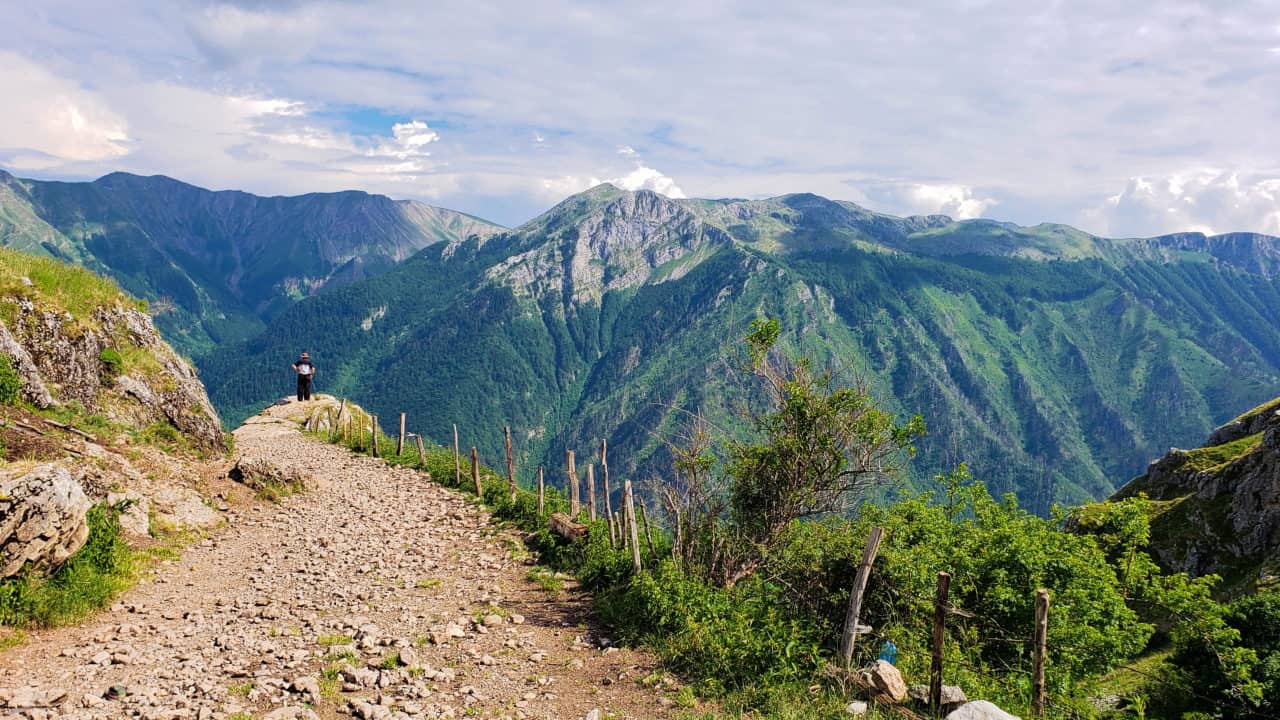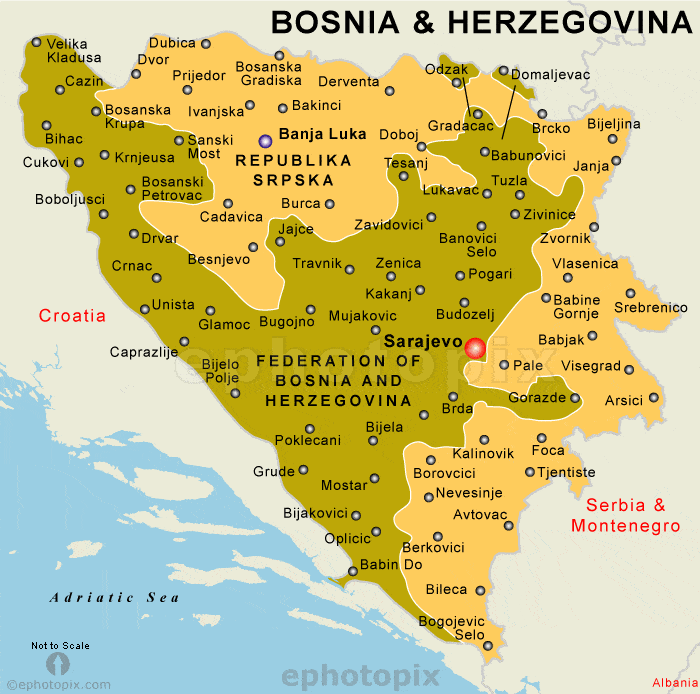One Country; Three Presidents, Two Prime Ministers and many more

Below is a summary of the most unusual, weird and somewhat fascinating political system that I have ever heard about. You can stop reading here if you don’t want to know about the country with three presidents at the same time!
To start, you need to understand that Bosnia and Herzegovina has three constituents, or three peoples, none of which are referred to as simply Bosnians. The largest group in the country are the Bosnian Muslims or Bosniaks at almost 50%. Next you have the Bosnian Serbs who are Orthodox Christians at 31% and Bosnian Croats who are Roman Catholic at 15%. This division of people is crucial to the entire political structure and to society as a whole. Segregation is maintained in some (most?) of the schools. People of different ethnicities may live side by side by they usually live very separate lives.
Bosnia and Herzegovina is divided in more different ways than you can imagine. First the two-part name, which has the least importance of all the divisions. Herzegovina means Herzog’s Lands and was an area in the south, ruled a long time ago by a duke. Although there are no political implications to being in Herzegovina, as a tourist you see it identified separately in lots of brochures and various materials. The city of Mostar holds significance as the cultural and administrative center of Herzegovina. Obviously, “Herzegovina” has significance to the people who live in this part of the country.
Many of us remember the name Slobodan Milosevic. He was President of Yugoslavia until 2000. He died in The Hague in 2006 where he was on trial on charges of genocide, crimes against humanity, and war crimes. Milosevic created a military that was 90% Serbian. Yugoslavia began to collapse in 1991 when the republics of Slovenia and Croatia declared independence. Bosnia came next in 1992. Following their independence, Serbian forces accompanied by Bosnian Serbs attempted to stop the separation and to ethnically cleanse the territory of Bosniaks (Muslims). The war in Bosnia and Herzegovina claimed the lives of an estimated 100,000 people and displaced more than two million. The height of the killing took place in July 1995 when 8,000 Bosniaks (Muslims) were killed in what became known as the Srebrenica genocide, the largest massacre in Europe after the Holocaust.
In 1995 a peace agreement was signed that established two semi-autonomous entities within Bosnia-Herzegovina: the Federation of Bosnia-Herzegovina, inhabited primarily by Bosniaks (Muslims) and Bosnian Croats (Roman Catholic), and the Republika Srpska (pronounced Serp ska), dominated by Serbs (Orthodox), both entities with their own political structures, economies, and educational systems, though connected through a central government. Note that “Federation of Bosnia-Herzegovina” refers to one of the two entities and not to the central government. An oversimplification of this is comparing the two entities to provinces or states, split largely on religious grounds. There is a central government and two provincial or state level of government which have a lot of powers. The Republika actually has its own passport which isn’t accepted by most countries. The light yellow areas on the map below are Republika Srpska. The darker yellow is the Federation of Bosnia and Herzegovina. Discussing this is tricky as the term federal is used to refer to the Federation, not the central government. The term national seems to be used to refer to the Federation or the Republika individually and not to the central, top-level government. If a Bosnian Serb is a Nationalist that means that he/she favours the Republika over the country and probably wants separation. Two of the three religions or constituents are Christian, yet they are as divided from each other as are the Muslims from either of them.

Nationally Bosnia has three presidents simultaneously, one Croat, one Bosniak, and one Serb. Each president is able to veto legislation that is seen as threatening to his own group’s interests. It has been nearly impossible to come to consensus for most of the important issues at the central-government level. The country often abstains from voting at the UN because there is no consensus between the three groups. This system excludes all other minority groups such as the Roma and Jews.
One of the three presidents is designated as Chairperson. This sounds very much like “First Among Equals”. The position of Chairperson rotates twice around the three members every eight months. Each candidate for the presidency is “self-defined” and can only claim one identity. You cannot have someone standing for president (or voting for a president) that considers themselves as simply Bosnian. This implies to me that there can never be a nationalist, in the truest sense of the word, leading the country. If you are Jewish, or Roma or any other minority not recognized as one of the 3 main constituent peoples, and want to vote, you would have to declare yourself as one of the three “constituent peoples”, perhaps a Roman Catholic? To an outsider it all seems very strange. Even a local woman told us that this was confusing and that a lot of locals didn’t really understand their own system.
An article written in January of this year about the Bosnian Serb President Milorad Dodik had some interesting highlights. “Few national leaders would call their own country an “impossible state.” Fewer still would actively advocate for it to be broken up. Almost none would risk a decades-old peace accord to do so. And then there is Bosnia’s Milorad Dodik.
“I am a Serb … Bosnia is only my place of employment,” Dodik proclaimed just a day after his inauguration as Bosnia’s head of state. A Serb nationalist, he has publicly called for the statelet he comes from, Republika Srpska, to break away from Bosnia.
Before his inauguration in November 2018, Dodik brought the flag of Republika Srpska to Sarajevo, where he planted it outside his new office in the presidency building. Dodik stated that if Republika Srpska’s flag was not displayed in the building, he would refuse to hold presidency sessions.
Previously, at a new student dormitory in the town of Pale, Dodik unveiled a plaque to a man found guilty of committing genocide at Srebrenica, where thousands of Bosnian Muslims were killed.”
Mike and I saw a wedding procession in a town in Republika Srpska. We noticed that the flags that were flown were the Republika Srpska flags and not the national flag.
Elections are very dependent on ethnicity. The House of Representatives, at the national or central government level, comprises 42 members elected under a system of proportional representation (PR). Two thirds of the members are elected from the Federation (14 Croats; 14 Bosniaks) and one third from the Republika Srpska (14 Serbs). In 2010, about 3/4s of the seats were elected by PR and the remaining seats by compensatory PR.
At the entity level (i.e. regional government, sort-of), both the Federation and the Republika Srpska have their own Prime Minister, 16 ministries and significant autonomy. All of these political positions are filled and voted on based on your declared religion or ethnicity.
Can you imagine voting day!
P.S. I purposely skipped the small district of Brčko which is largely self-autonomous and yet somehow part of both entities and regions. You are correct, I do not understand all of this and don’t think I ever will!

Leave a Reply